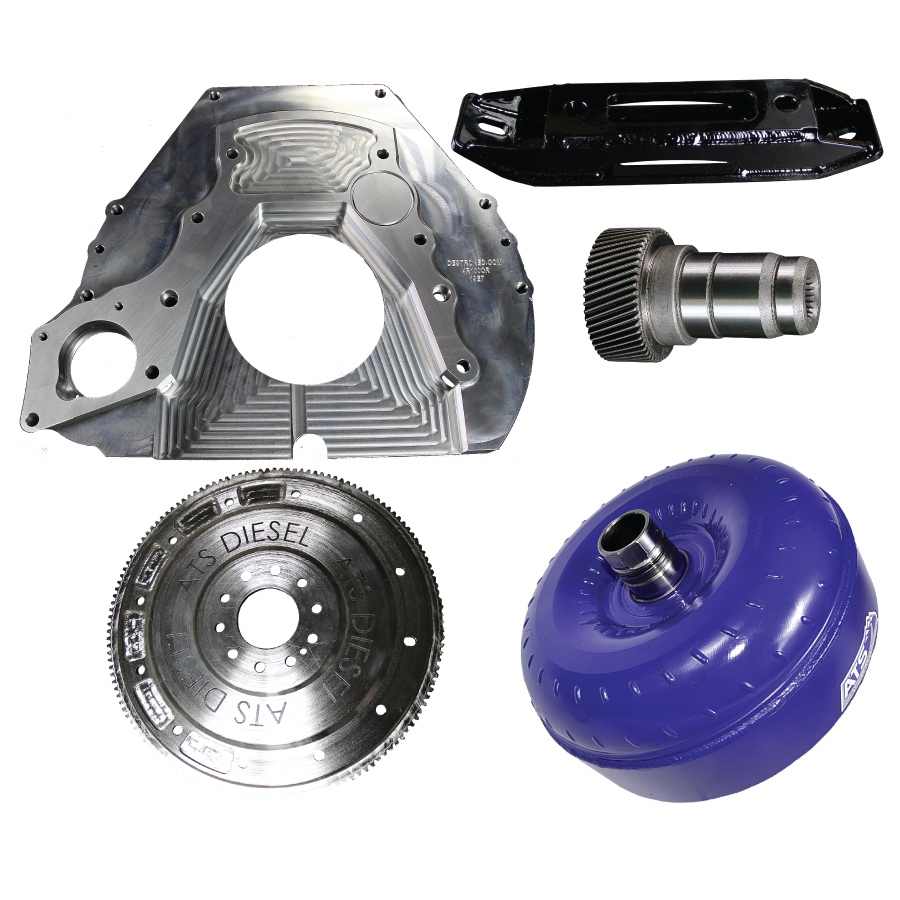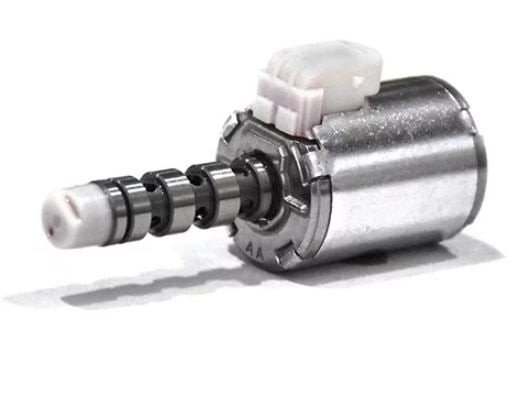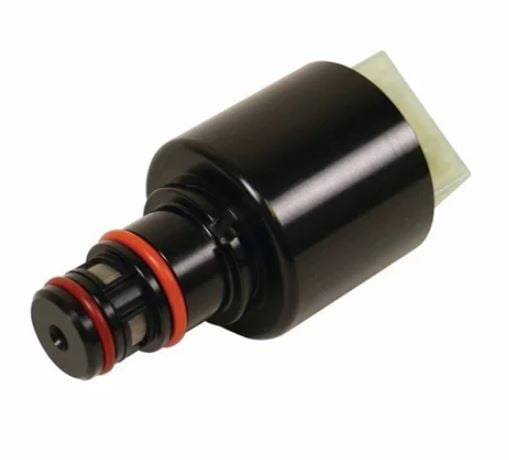Generally, each truck brand is recognized for one of its major strengths: Chrysler is known for the legendary Cummins engine under the hood, GM is known for its smooth riding IFS chassis, and Ford makes some of the best transmissions in the game. For most diesel owners, adding power is as second nature as breathing, and one of the reasons diesel performance is popular is because it’s so easy to add tons of extra power. If you started with a naturally aspirated gas V8 for example, an intake, full exhaust, and tune might only net you another 40-50 horsepower at the wheels. By comparison, most diesel trucks can easily pump out an extra 160 or more horsepower with the equivalent upgrades, and nearly double that in torque gains. While an extra 40 horsepower is never going to hurt the drivetrain on a car, that huge gain in power and torque combined with a 7,000+ lb. truck can push some drivetrain parts well past their design parameters and into an early grave.
So, the question of the day is how much extra power can you throw at your truck before you have any mechanical failures? Luckily for all the heavy-duty diesel trucks out there, the transfer case and front/rear differentials are very strong and can take just about any abuse most owners can throw at ‘em, but most automatic transmissions aren’t so fortunate. Dodge had had bad luck in the automatic transmission department, and most of their stock autos just aren’t up to the task, even at a stock power level. With the Allison 1000, you can usually get away with adding another 100-150 extra horsepower depending on the version, and it will last for a reasonably long time. Whether you’re a Chevy or Dodge owner, anything more than a good tune will exceed what your transmission can typically handle, and if you want to push your horsepower even higher, the transmission has to come out, and a stack of cash has to be put back in. You just have to accept this as a fact of life as a diesel truck owner, and it’s understandably no fun to build your transmission since the money spent doesn’t make the truck any faster, therefore the fun factor per dollar spent ratio is very low. There is a way to work around this transmission issue however, it just requires you to look beyond GM or Chrysler products and take a walk with the blue oval.
First Try: Pretty Good
When Ford introduced the 7.3 Powerstroke in 1994, they needed an automatic which could handle the torque output and towing duties the truck would see. At first, the power and torque figures weren’t much to write home about, as the 7.3 only put down 210hp and 425lb.ft. of torque. The first automatic Ford stuck behind the 7.3 was the E40D, which was more or less an updated version of the C6 three-speed which had been used since the late 60’s, except this version was a four speed with overdrive. The ratios spread between 2.71:1 in first to 0.71:1 in overdrive, which is a good match for the 7.3. When Ford changed the body style to the Superduty in 1999, the 7.3 got an upgraded automatic, this time called the 4R100. It shared the same exact gear ratios and many other design elements as the E40D, but notable changes included a stronger torque converter, steel planetary gears, and improved hydraulics making it a bit more durable.
As long as you are running a stock power level from your 7.3, either the E40D or the 4R100 will have no issues, but as soon as you increase the power output, you are skating on thin ice. The E40D is by far the weakest transmission put behind a Ford Powerstroke, but that’s not to say it won’t handle any extra. The ultimate failure point of any transmission depends on many factors including mileage, fluid temp, tire size, towing habits, and of course maintenance history, but on average it will hold another 80-100hp. The 4R100 is a little bit stronger, but a good rule of thumb would be the stock transmission can handle an intake, exhaust, and tune, but no more. Once you start bolting on larger injectors and an HPOP or even a bigger turbo, the stock transmission will say sayonara. The good news, however, is both four-speed Ford automatics can be built to handle a ton of power without spending a lot of money. You can take advantage of this fact even if you own a 6.7 Cummins which normally has a 68RFE. If you’re tired of the glitches and issues with are inherent with the clutch to clutch design, you can grab a conversion kit from ATS Diesel which will allow you to attach the more reliable and simpler 4R100 to your 6.7. The evenly spaced ratios will make your Cummins a blast to drive, and you’ll never have to worry about your 68 again.

BD Diesel makes transmission products for a wide range of trucks, and they have plenty of options for Ford. Whether you want to build one yourself or would prefer an assembled transmission to show up in a crate ready to drop in, they have you covered. For the latter, they offer a transmission and converter package which has been fortified to work with a high performance Powerstroke, and it’s a bargain at just over $4,000, especially when compared to how much some other types of transmission can cost to build. In each clutch pack, BD has fitted an additional friction disc to improve holding power, the valve body has been modified to allow more main line pressure for quicker more positive shifts, and it features all steel planetary gearsets. On top of that, it comes with extras like a high capacity pan and an auxiliary filter kit to help the trans run cool and clean for a long time to come. If you are more into assembling the transmission yourself, you can pick up the same exact rebuild kit which goes in their house-built transmissions and save yourself the labor costs and downtime from waiting for shipping, plus avoid a core charge.
Second Try: Even Better
In 2003, Ford introduced a whole new diesel engine, the 6.0 Powerstroke, and it ran until 2007. Yes, the six-liter had its problems, but the transmission which was attached to it was a rock star from day one. First off, it had nothing in common with the earlier units, and was an all-new design with 5 forward gears ranging from a deeper 3.11:1 first to the same 0.71:1 overdrive as the earlier models. The other feature which sets the 5R110 apart from any earlier Ford transmission is its adaptive or learning feature. In order to provide a smooth shift, the transmission is constantly measuring how much time and fluid volume is needed to execute a shift, and the TCM makes changes on the fly to compensate for clutch wear and driving habits to meet what is considered the “ideal” shift. The 5-speed worked great behind the 6.0, and when Ford released the 6.4 Powerstroke in 2008, the same 5R110 was utilized, although it got a different torque converter and some tweaks to the planetary gearset to make it even stronger. When it comes to hot-rodding, the 5R110 TorqShift is in a league of its own, and in bone stock form can handle a ton of abuse. The 6.0 version is perfectly happy at 550hp, and the updated 6.4 version has been pushed by many owners to well over 650hp and will last for a fair amount of time. This might not be recommended, but it does hold up surprisingly well. The same cannot be said for any other diesel transmission: not the 68RFE, AS69, or any version of the Allison. Hands down, Ford takes the cake with this transmission.

The one Achilles heel the 5-speed TorqShift does have, is a failure of the direct clutch, which is engaged while in 5th gear and reverse. When used in a high-performance application, the stock direct clutch solenoid cannot flow enough fluid to engage the clutch quick enough, so there is a little slippage which will occur during the shift. Over time, this repeated slipping can burn the clutches and cause a failure, but the simple solution is to fix the slow engagement before a clutch failure occurs. XDP has figured out a way to modify the direct clutch solenoid to flow more fluid in a shorter amount of time and prevent any slippage during the gear change, and for the majority of 6.0 and 6.4 owners, this is the only modification needed to the transmission. Of course, if you are planning on pushing the limits closer to the 1,000hp mark, you will need to beef it up a bit more, but there are options there as well. If you need to tow heavy loads or spend a ton of time at the track, an ATS Stage-3 5R110 will handle anything you can throw at it. It comes with a billet input shaft and flexplate, as well as a five disc torque converter, modified pump and accumulators for better shifting feel, and best of all it comes with a 5-year 500,000 mile warranty which has you covered regardless of how much power you are throwing at it, or what you are doing.
Third Try: Best One Yet
If five gears are great, then six must be spectacular, right? Even though the Allison 1000 got its 6th gear in 2006, Ford waited until the 2011 release of the 6.7 Powerstroke to also show off the new 6R140. Since Ford figured the trucks with this transmission would be doing a lot of towing, it got a deep 3.974:1 first gears and a double-overdrive ratio of 0.674:1 in 6th, making for easy acceleration when loaded, and low RPMs when cruising down the highway, and strength wise, it might as well be bomb proof.
Bone stock, the newest 2019 6.7 Powerstrokes are making 450 horsepower and 935 pounds of torque which would be a challenge for any automatic, but the 6R140 handles it with ease. In fact, even when pushing 700hp, the six-speed will hardly complain. Because of how robust the transmission is, there are very few aftermarket parts, especially when compared to the Allison of 48RE. There are a few simple parts you can install to make it even better, like the BD Pressure Enhancer Solenoid which will provide an additional 79% clamping pressure inside the transmission which will prevent shift flares and clutch slipping, and require no tuning changes to be made inside the transmission. This will work with a stock or mild build, but if you want to take your 6.7 to the extreme, your trans will need some extra sauce. Maryland Diesel Performance can get you the turbo system needed to make the horsepower you want from your Powerstroke, and the transmission to back it up. Their Stage-Two 6R140 is rated at 1,200hp and is filled with goodies like custom clutch packs, billet shafts, and a quad disc torque converter to make the connection between the engine and transmission.

Shifting into the Future
It’s important to remember, there are a lot of factors which determine how long any transmission will last, and power level is just one of those. Mileage, neglect, tire size and gear ratio, fluid temp, and normal wear all come into play. Ford has built some very impressive transmissions over the last decade, and it’s exciting to see what they will come up with next. They just announced an all-new 10-speed automatic which will compete head to head with GM’s 10L1000 behind the L5P, and it surely will be a beast since it was also just announced the newest 6.7 Powerstroke will be producing 475hp and a record shattering 1,050 pounds of torque. The one thing we know for sure, is Ford knows how to design a transmission which can handle a ton of power. Arguably, this is the one reason why many enthusiasts prefer to modify a Ford, since you can spend your budget on go-fast goodies, instead of on supporting modifications which don’t make you go any faster. At the end of the day, Ford has set the bar when it comes to the automatic transmission.


Super Duty truck owner a 6.7 Powerstroke with a deleted truck with 510 horsepower having tranny probablys do u have a tranny that can be dropped in to replace factory we pull 40’ trailers on 3 units two with six speed and the ten speed stumbles all over 9-10 back to 8th can’t make up its mind where it need to pull in and went into limp mode in Oklahoma and at dealership if u have transmission please drop me a line it going to get a crappy factory new ten speed in so drop me a line Michael